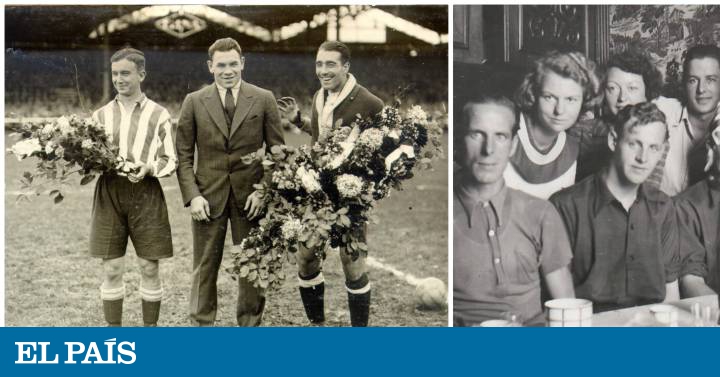The Bidasoa river separates the municipalities of Irún and Hendaya. One shore belongs to Spain, the other to France. From the channel emerges the Island of the Pheasants, the smallest condominium in the world. A few meters from the islet was the customs agency of Anatolio Anatol, a Frenchman married to an Irundra. To the marriage, the boys became adventurers. The oldest son, Manuel Anatol, was a physical portent. He ran, jumped and participated in automobile tests with his Bugatti, although he ended up opting for soccer. Her sister Maritxu was part of the Comet Network, a clandestine organization that helped evacuate pursued by the Nazis. Another of the six brothers, Jesús María, was captured by the Germans while fighting in World War II. Years later, France awarded him its highest distinction for his scientific findings.
The history of the Anatol was diluted in history like a sugar. Manuel, who died in France three decades ago now, was a singular character. He was born in Irún in 1903 and at just 17 years old he debuted with Real Unión, one of the ten teams that founded La Liga in the late 1920s. Professionalism did not yet exist and the clubs only provided jobs and study grants. Manuel was preparing to be an engineer. José Antonio Martín Petón describes him as a “long-range” student, one of those who live on family complacency. His father's ultimatum took him in 1922 to Madrid, where he joined the Royal Spanish Gymnastic Society. The following year he returned to his city and, in 1924, he was part of the team that won the third of the four King's Cups owned by the Real Unión de Irún, which is now in the Second Division B.
March to France
“Manuel belongs to our best time. We competed with the best. One of our team, Arabolaza, scored the team's first goal, which we nurtured as footballers, ”recalls Carlos Fernández de Casadevante, who chaired the Barcelona team in the 1990s. His book covers the first century of the institution's history. Anatol is one of the protagonists, although in 1925 he asked to change Real Irún for Athletic Bilbao. He ended up playing with the lions a year later, for two seasons. In 1928 he went to France to perform compulsory military service, since he chose paternal nationality. For four seasons he was part of Racing de Paris, where he made a name for himself thanks to his pride in the right-hand side of the defense (the teams then played with only two defenders).
The French team had spent years trying to summon Anatol, which would have cost him to lose his sports license in Spain. The slim defender had to wait until 1929 to debut, after being authorized by the Spanish federation. The only limitation was not to face them; therefore, when he was called in 1932 to play against the Red Fury, he refused. He would never put on the elastic Blue again , which he managed to captain. Petón explains in his book Soccer has music that Anatol's career was a continuous coming and going between France and Spain. Despite signing his signing for Real Madrid and signing for Valladolid, he ended up playing for Atlético de Madrid. He even had to take over the mattress team after the dismissal of Walter Harris. It was his only foray onto the bench. He then returned to France, played at Montpellier and hung up his boots at Racing de Paris in 1935.
“For the world he was a footballer, but for us he was an athlete. He is the only one who managed to be champion of Spain in 100, 200, 400 and 4x400 meters the same year, "reveals Fernando Lozano, from the Txingudi Athletics Taldea Sports Club. The files of the Spanish Association of Athletics Statisticians reveal that Anatol traveled the 100-meter dash in 11 seconds and eight hundredths and that he won the rest of the tests in the championships held in August 1923 in the Biscayan town of Getxo. But his name does not appear on the record. The Spanish Athletics Federation explains that his victories for having French nationality were not validated. The same thing that had happened in 1922, when he equaled the Spanish record in the 200 meters in the Atocha field, in San Sebastián. However, his specialty was the 400, where he achieved the best national brand for two consecutive years. "Anatol was a pioneer who introduced physical fitness to soccer," insists Lozano.
The resistance
more posts from this blog
Robot, put me a rod!
Valladolid will use drones to monitor compliance with time slots and activities during deconfinition
The inhabitants of the emptiest Spain: "Many will realize now, here one lives very well"
His track is lost in the Civil War. He established his residence in France, where he died on May 17, 1990. There he ran an arms company, but never had contact with football again. It is then when the figure of his sister Maritxu emerges. Born in 1909, she went to work very young with her father at the customs agency, something that many did not see with favor at that time due to her condition as a woman. After the military uprising, he went to live in Béhobie's family home, on the French shore of Bidasoa. The house was confiscated by the Germans in June 1940. The Nazis occupied the first floor and she lived on the second floor. Alejandro Elizalde offered him to work for the Resistance and Maritxu, who had an adventurous spirit, as recognized by the Deia newspaper in 1978, accepted.
Jesús María, younger than Manuel and Maritxu, fought with France during World War II, but was taken prisoner by the Nazis in the summer of 1940. He remained for almost five years in a concentration camp near the Elbe river, until he was released by the Russians. He then obtained a doctorate in science and made several scientific findings for which he received the Knight's Cross of the Legion of Honor.
“She was in charge of collecting information and collaborated by passing fugitives. He was part of the Comet Network and his mission was to evacuate allied airmen shot down by the Nazis in occupied territory. I was driving them to Spanish soil and a car from the British Embassy was taking them to Gibraltar, ”says historian Juan Carlos Jiménez de Aberasturi. His book Camino a la libertad recounts the adventures of Maritxu, who before dying in 1981 claimed to have saved the lives of 39 Jews and 113 pilots of different nationalities. A defender of race, like her brother Manuel.
Read more blog topics and follow us on Flipboard







/cloudfront-eu-central-1.images.arcpublishing.com/prisa/K4WCA3FYAVFMBI445RXQV5RF3I.jpg)



/cloudfront-eu-central-1.images.arcpublishing.com/prisa/KMEYMJKESBAZBE4MRBAM4TGHIQ.jpg)


